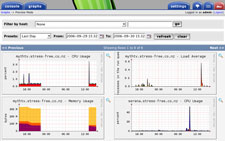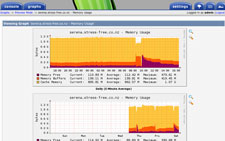Steve Wray put me on to Cacti the other day and I must say its pretty nice once you get over its slightly confusing interface. Cacti graphs statistics from network devices but unlike similar tools it does not try to do anything else. Think of it like bling for your network, good to look at, but maybe not that practical in a network emergency. But just like bling it is easy to put on and even better it is sure to impress your system admin friends, which in those hot and steamy server rooms we all want to do...
Installation is straightforward if you are running a typical LAMP stack (Linux, Apache, MySQL and PHP) but it can also run on a number of platforms including Windows if you are desperate. Cacti uses the PHP-SNMP extension to talk to SNMP agents on the network, keeps configuration settings in MySQL and stores accumulated network information as RRD files that get processed by RRDTool. Users can be configured with different access rights and devices/graphs can be clustered together in trees for easy viewing.
 |  |
| Click to enlarge screenshots | |




